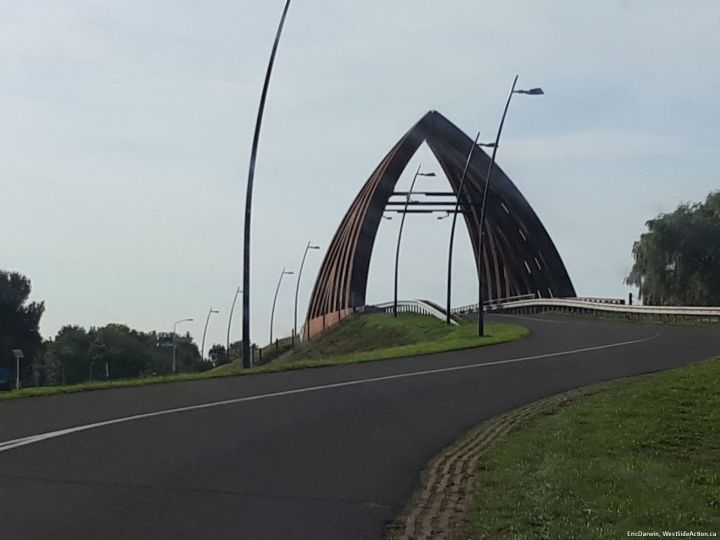The Netherlands, and Europe generally, has a reputation amongst North American progressives as transit, train, and walkable-city nirvana. The reality is quite different. Suburbanization is accelerating, and with it, ring roads and strip development. Car commuting is as popular there as in Canada.
Sneek, NL, has a wonderfully walkable and lively old town. And extensive car-oriented suburbs, albeit with a higher degree of walkability and cyclability than here. But those features are waning. A new ring road (freeway) increases suburban accessibility (for those with cars and trucks) and there were kilometres of new businesses in free standing buildings surrounded by parking lots and not exactly charmingly accessible by bus or bike:
The portion of road shown in the picture above has an adjacent cycle path and safety railings. While carrying a freeway, it at least connects by foot and bike the urban areas on both sides of the overpass. Note that the blue sign indicates the office park / commercial area is to the right.
What’s that in the distance?
It is a pair of wooden overpass bridges. Freeways and strip development and suburbanization redeemed by a pair of sustainable wood bridges?
Better than nothing, I suppose. But what if we tried a bit harder toward alternatives to that conversion of an already walkable/cyclable/busable city to an auto centric one? We will explore some of those alternatives in coming stories, but for now, those bridges …
Our tour is by car, of course, as we go under and over the bridges …
Note please the additional concrete overpass to the right of the bridge, for future freeway expansion. I wonder if there were limits to the wooden span?
The street lighting poles bend to match the bridge:
Note that the road over the freeway isn’t a freeway itself, but a two lane road.
there is a cycle path on one side of the bridge (to the right) and look! a pedestrian! :
The basket-weave sides were attractive, making the best of what is a very heavy-looking construction.
I am confident that new techniques may make future bridges sleeker, and use fewer trees, although the EU has a curious attitude to trees, considering burning forests to generate power as being “green”. The details as to the sustainability of large wooden structures is no doubt complex and beyond me. But as branding / a distraction from the suburbanization and auto dominance of the rest of the infrastructure, it works.
At a recent open house for the new Ottawa Public Library, an attendee suggested we look at a wood building. Given that the new building won’t be a high rise, it’s low-and-long shape might well be conducive to wood construction.












Wood construction is certainly on the rise in Canada. Many construction magazines suggest its application even in medium rise building.
The idea of using wood for the library is a good one and should be explored by the architects.
However, there was a reason (which is still valid) why we here, and in New England, had covered wooden bridges. Weather tends to be unkind to exposed structural wood. The size of structural members reflects their relative structural strength, which, compared to steel, is a fraction thereof. You may recall the massive looks of some cement bridges as well, when they have above ground structures. The center of Galt (now Cambridge) Ontario comes to mind.
You wrote: “although the EU has a curious attitude to trees, considering burning forests to generate power as being “green”.”
Using wood pellets as a source of heat or energy is certainly more “green” than alternate use of coal or oil or gas. The latter often imported from Russia. And some pellets contain much former bark, sawdust and other wood scrap or recycling.
They are now commonly used in rural/cottage Canada too to replace expensive heating oil or electricity.
Bernie, like so much in today’s world, the issues are complex beyond my ability to fully understand them, so I make my best judgement calls. For a critical review, see Why Wood Burning is Counted as Green Energy, from Yale Environment 360, which was reprinted in Green Building Advisor back on Jan 30, 2018.
The story contains numerous other links to research critical of wood burning as fraudulent green energy. The GBA story has no paywall.